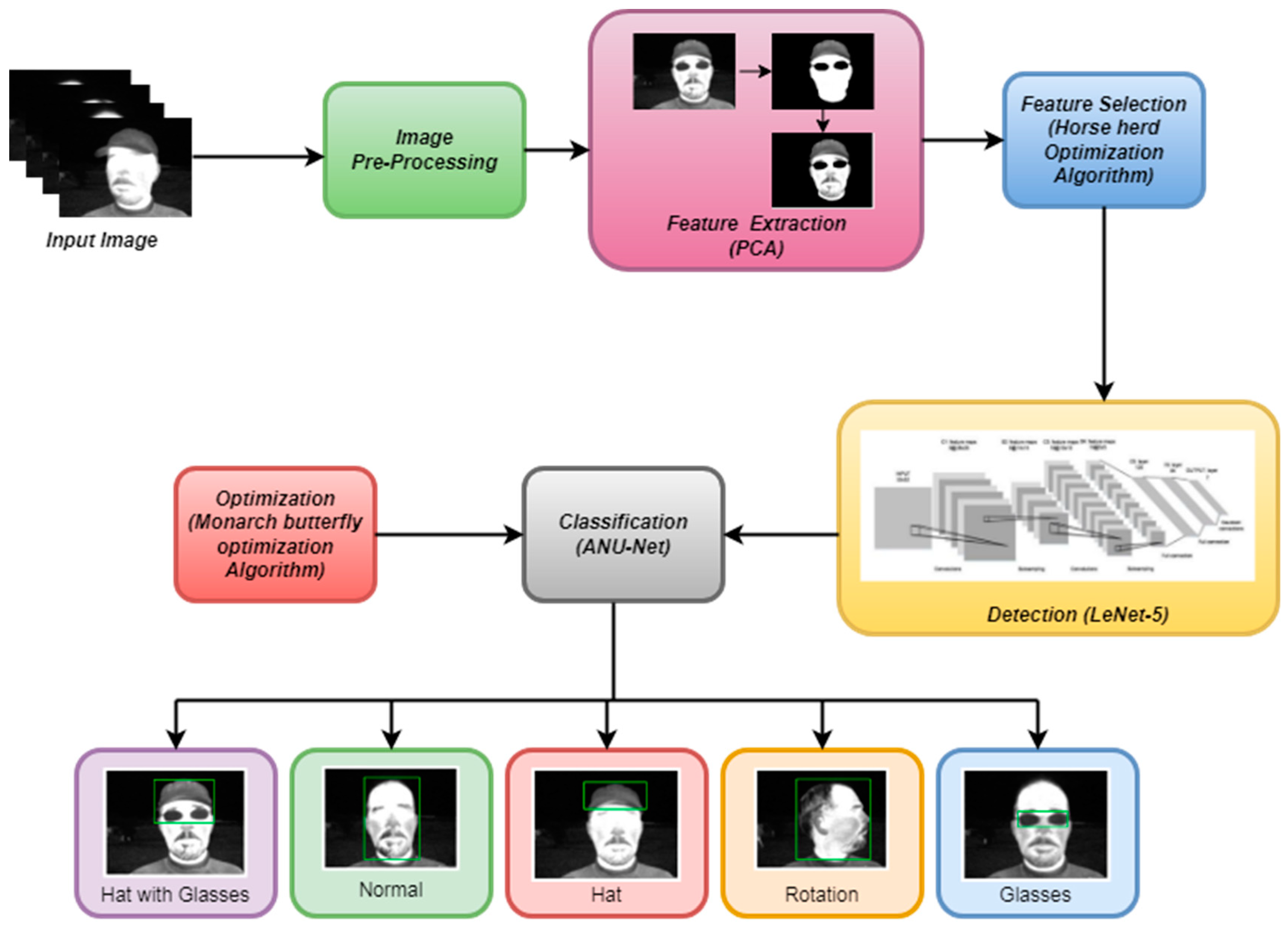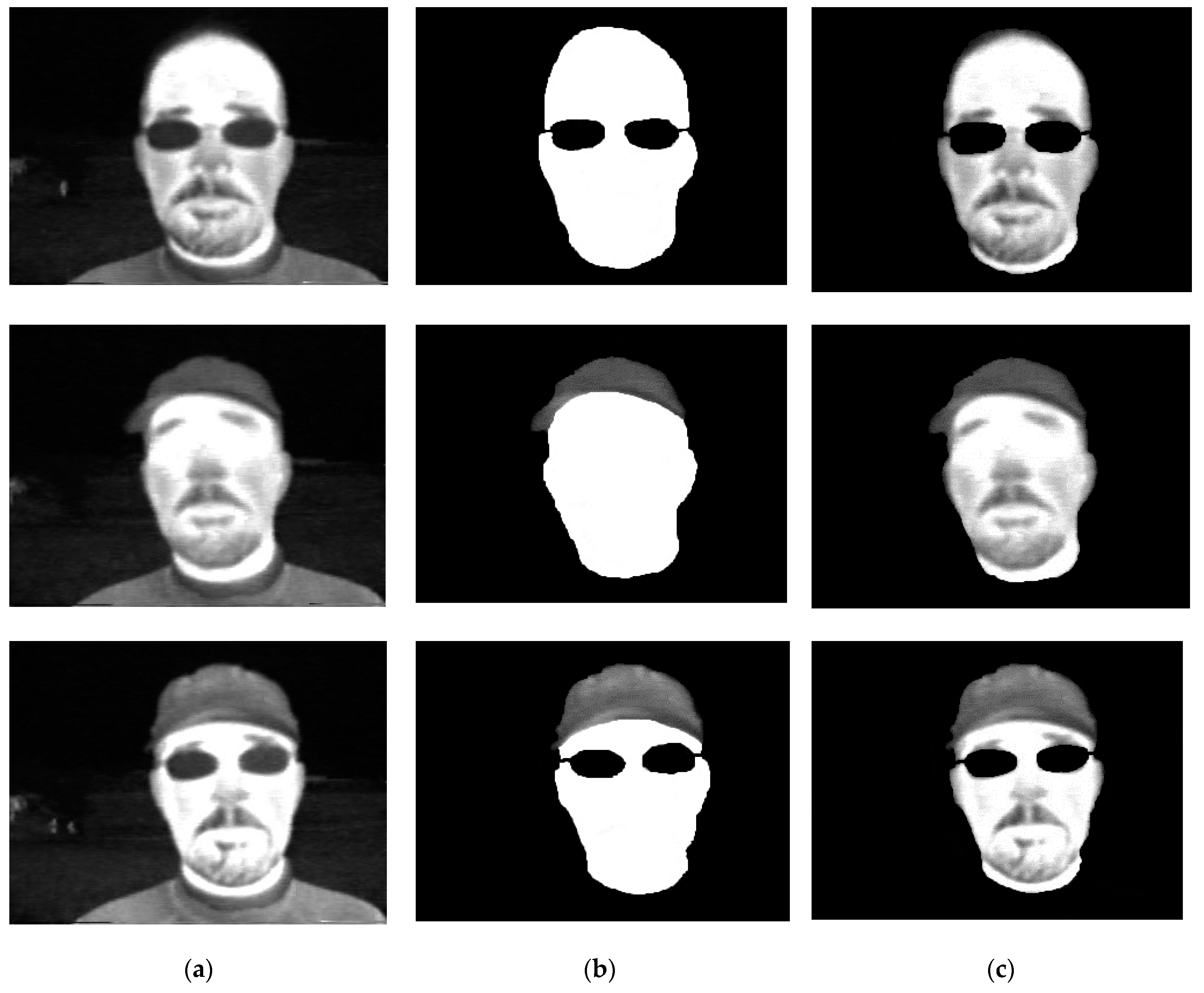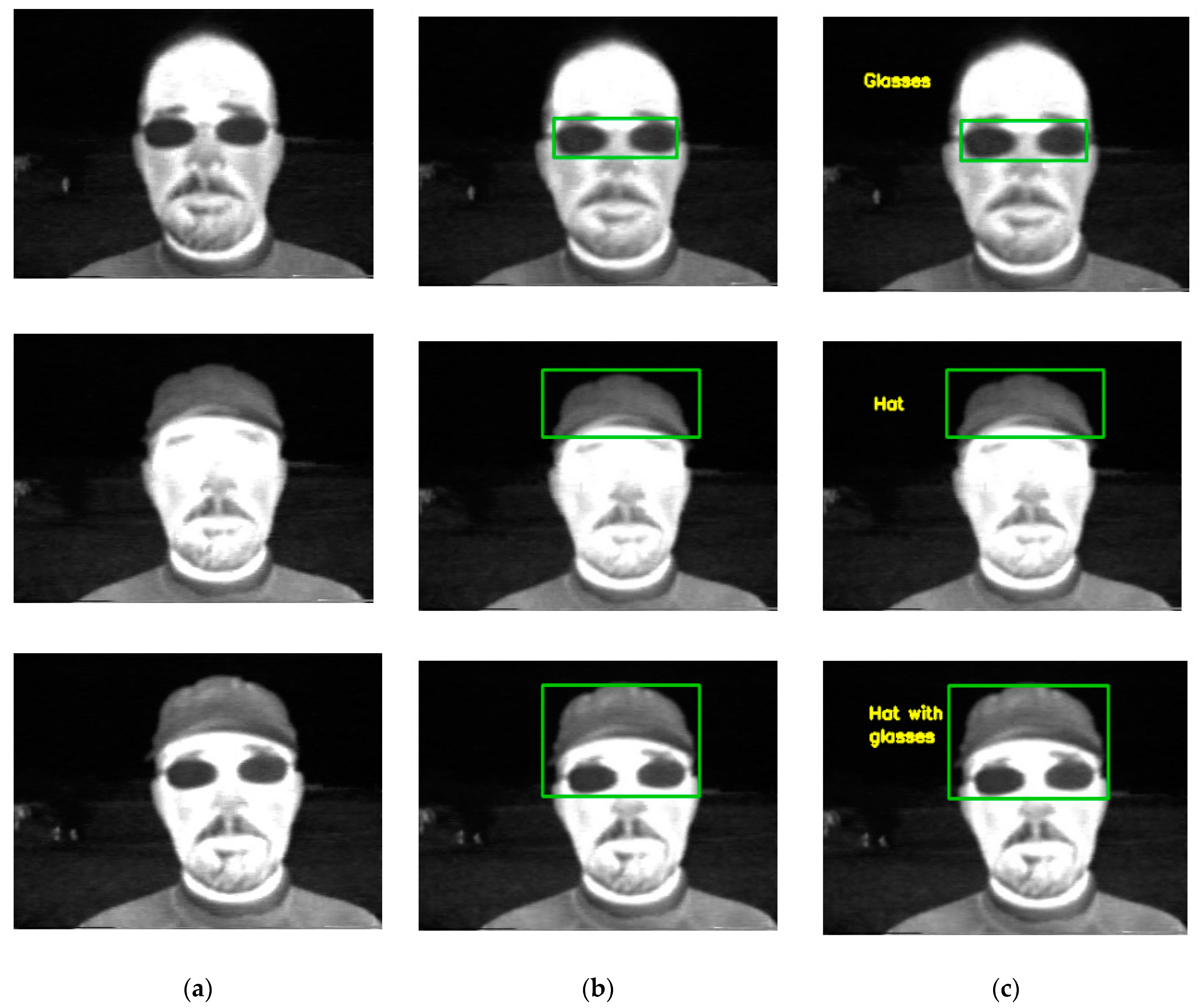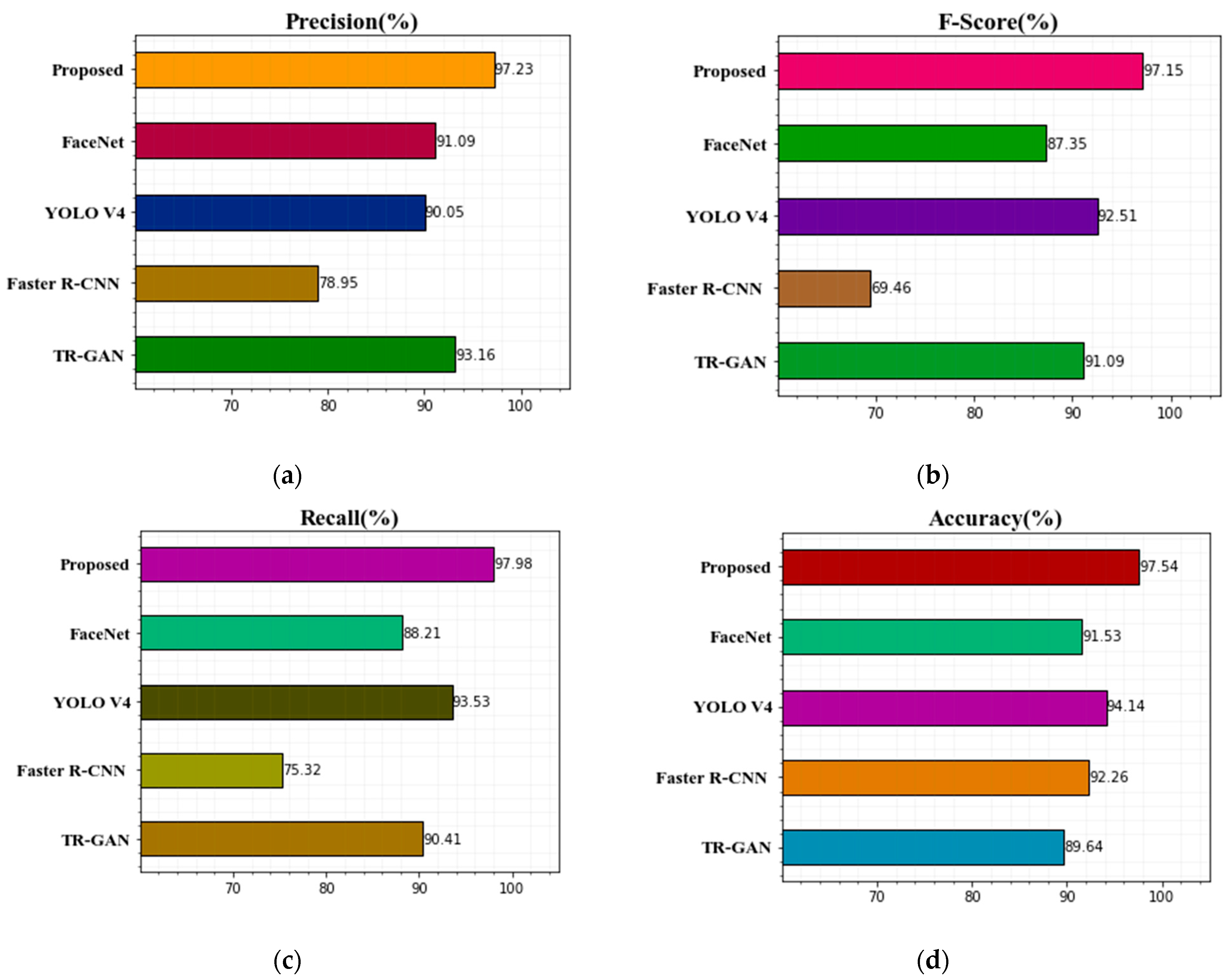Objects and Action Detection of Human Faces through Thermal Images Using ANU-Net
Abstract
1. Introduction
- ➢
- Resizing the images and grayscale thermal input images by using a median filter in the pre-processing stage.
- ➢
- A principle component analysis (PCA) approach is proposed to extract the features of images. It extracts features such as glasses, a hat, or other specific objects from the pre-processed face image.
- ➢
- The horse herd optimization algorithm (HOA) is used to select the features.
- ➢
- A LeNet-5 technique is utilized to detect or identify the human face from thermal images. The detection of the face process is important to classify the objects and actions on the face.
- ➢
- We used the ANU-Net methodology for the classification of objects and actions on faces in thermal images with the Monarch butterfly optimization algorithm to obtain higher accuracy.
- ➢
- This paper proposed a method for detecting several face objects and actions in thermal images utilizing the Terravic Facial Infrared Database, a dataset of facial images for facial object recognition.
2. Literature Survey
3. Proposed Methodology
3.1. Preprocessing
3.2. Feature Extraction
3.3. Feature Selection
3.4. Detection
3.5. Classification
3.5.1. Attention Gate (AG)
- As a gating signal to facilitate the learning of the next input, the first input (g) is used (f). In other words, this gating signal (g) can choose more advantageous features from encoded features (f) and transfer them to the top decoder.
- These input data are combined pixel by pixel following a CNN operation (Wg, Wf) and batch norm (bg, bf).
- The S-shaped activation function sigmoid is chosen to obtain the attention coefficient (α) and to perform the divergence of the gate’s parameters.
- The result can be produced by multiplying each pixel’s encoder feature by a certain coefficient.
3.5.2. Attention-Based Nested U-Net
3.6. Monarch Butterfly Optimization (MBO) Algorithm
- Either Land 1 or Land 2 is home to all of the butterflies (the home after migration).
- No matter if the parents are in Land 1 or Land 2, the migration operator generates each butterfly’s offspring.
- Out of the parent and offspring, one of the two will be eliminated by a candidate function because the population should not change and should be constant.
- The butterflies chosen using the candidate function are handed down to the following generation without being altered by the migration operator.
3.6.1. Migration Facilitator
3.6.2. Butterfly Adjusting Operator
4. Results and Discussion
4.1. Dataset Description
4.2. Evaluation Metrics
4.2.1. Accuracy
4.2.2. Precision
4.2.3. Recall
4.2.4. F-Measure
4.3. Quantitative Evaluation
4.4. Performance Metrics
4.5. Evaluation of Training Results
4.6. Computation Time
5. Conclusions
Author Contributions
Funding
Institutional Review Board Statement
Informed Consent Statement
Data Availability Statement
Conflicts of Interest
References
- Mittal, U.; Srivastava, S.; Chawla, P. Object detection and classification from thermal images using region based convolutional neural network. J. Comput. Sci. 2019, 15, 961–971. [Google Scholar] [CrossRef]
- Silva, G.; Monteiro, R.; Ferreira, A.; Carvalho, P.; Corte-Real, L. Face detection in thermal images with YOLOv3. In International Symposium on Visual Computing; Springer: Cham, Switzerland, 2019; pp. 89–99. [Google Scholar]
- Bhattacharyya, A.; Chatterjee, S.; Sen, S.; Sinitca, A.; Kaplun, D.; Sarkar, R. A deep learning model for classifying human facial expressions from infrared thermal images. Sci. Rep. 2021, 11, 20696. [Google Scholar] [CrossRef] [PubMed]
- Teju, V.; Bhavana, D. An efficient object detection using OFSA for thermal imaging. Int. J. Electr. Eng. Educ. 2020. [Google Scholar] [CrossRef]
- Lin, S.D.; Chen, L.; Chen, W. Thermal face recognition under different conditions. BMC Bioinform. 2021, 22, 313. [Google Scholar] [CrossRef] [PubMed]
- Mahouachi, D.; Akhloufi, M.A. Adaptive deep convolutional neural network for thermal face recognition. In Proceedings of the Thermosense: Thermal Infrared Applications XLIII, Online, 12–17 April 2021; SPIE: Bellingham, WA, USA, 2021; Volume 11743, pp. 15–22. [Google Scholar]
- Abd El-Rahiem, B.; Sedik, A.; El Banby, G.M.; Ibrahem, H.M.; Amin, M.; Song, O.Y.; Khalaf, A.A.M.; Abd El-Samie, F.E. An efficient deep learning model for classification of thermal face images. J. Enterp. Inf. Manag. 2020. [Google Scholar] [CrossRef]
- Agarwal, S.; Sikchi, H.S.; Rooj, S.; Bhattacharya, S.; Routray, A. Illumination-invariant face recognition by fusing thermal and visual images via gradient transfer. In Advances in Intelligent Systems and Computing; Springer: Cham, Switzerland, 2019; pp. 658–670. [Google Scholar]
- Głowacka, N.; Rumiński, J. Face with mask detection in thermal images using deep neural networks. Sensors 2021, 21, 6387. [Google Scholar] [CrossRef] [PubMed]
- Padmanabhan, S.A.; Kanchikere, J. An efficient face recognition system based on hybrid optimized KELM. Multimed. Tools Appl. 2020, 79, 10677–10697. [Google Scholar] [CrossRef]
- Benamara, N.K.; Zigh, E.; Stambouli, T.B.; Keche, M. Towards a Robust Thermal-Visible Heterogeneous Face Recognition Approach Based on a Cycle Generative Adversarial Network. Int. J. Interact. Multimed. Artif. Intell. 2022. [Google Scholar] [CrossRef]
- Jiang, C.; Ren, H.; Ye, X.; Zhu, J.; Zeng, H.; Nan, Y.; Sun, M.; Ren, X.; Huo, H. Object detection from UAV thermal infrared images and videos using YOLO models. Int. J. Appl. Earth Obs. Geoinf. 2022, 112, 102912. [Google Scholar] [CrossRef]
- El Mahouachi, D.; Akhloufi, M.A. Deep adaptive convolutional neural network for near infrared and thermal face recognition. In Proceedings of the Infrared Technology and Applications XLVIII, Orlando, FL, USA, 3 April–13 June 2022; SPIE: Bellingham, WA, USA, 2022; Volume 12107, pp. 417–428. [Google Scholar]
- Manssor, S.A.; Sun, S.; Abdalmajed, M.; Ali, S. Real-time human detection in thermal infrared imaging at night using enhanced Tiny-yolov3 network. J. Real-Time Image Process. 2022, 19, 261–274. [Google Scholar] [CrossRef]
- Kanmani, M.; Narasimhan, V. Optimal fusion aided face recognition from visible and thermal face images. Multimed. Tools Appl. 2020, 79, 17859–17883. [Google Scholar] [CrossRef]
- Sancen-Plaza, A.; Contreras-Medina, L.M.; Barranco-Gutiérrez, A.I.; Villaseñor-Mora, C.; Martínez-Nolasco, J.J.; Padilla-Medina, J.A. Facial recognition for drunk people using thermal imaging. Math. Probl. Eng. 2020, 2020, 1024173. [Google Scholar] [CrossRef]
- Nayak, S.; Nagesh, B.; Routray, A.; Sarma, M.A. Human–Computer Interaction framework for emotion recognition through time-series thermal video sequences. Comput. Electr. Eng. 2021, 93, 107280. [Google Scholar] [CrossRef]
- Zaeri, N. Thermal face recognition under spatial variation conditions. Pattern Recognit. Image Anal. 2020, 30, 108–124. [Google Scholar] [CrossRef]
- Kezebou, L.; Oludare, V.; Panetta, K.; Agaian, S. TR-GAN: Thermal to RGB face synthesis with generative adversarial network for cross-modal face recognition. In Proceedings of the Mobile Multimedia/Image Processing, Security, and Applications 2020, Online, 29 April–9 May 2020; SPIE: Bellingham, WA, USA, 2020; Volume 11399, pp. 158–168. [Google Scholar]
- Jahirul, M.I.; Rasul, M.G.; Brown, R.J.; Senadeera, W.; Hosen, M.A.; Haque, R.; Saha, S.C.; Mahlia, T.M.I. Investigation of correlation between chemical composition and properties of biodiesel using principal component analysis (PCA) and artificial neural network (ANN). Renew. Energy 2021, 168, 632–646. [Google Scholar] [CrossRef]
- Asante-Okyere, S.; Shen, C.; Ziggah, Y.Y.; Rulegeya, M.M.; Zhu, X. Principal component analysis (PCA) based hybrid models for the accurate estimation of reservoir water saturation. Comput. Geosci. 2020, 145, 104555. [Google Scholar] [CrossRef]
- MiarNaeimi, F.; Azizyan, G.; Rashki, M. Horse herd optimization algorithm: A nature-inspired algorithm for high-dimensional optimization problems. Knowl.-Based Syst. 2021, 213, 106711. [Google Scholar] [CrossRef]
- Fan, Y.; Rui, X.; Poslad, S.; Zhang, G.; Yu, T.; Xu, X.; Song, X. A better way to monitor haze through image based upon the adjusted LeNet-5 CNN model. Signal Image Video Process. 2020, 14, 455–463. [Google Scholar] [CrossRef]
- Li, C.; Tan, Y.; Chen, W.; Luo, X.; He, Y.; Gao, Y.; Li, F. ANU-Net: Attention-based Nested U-Net to exploit full resolution features for medical image segmentation. Comput. Graph. 2020, 90, 11–20. [Google Scholar] [CrossRef]
- Alweshah, M.; Khalaileh, S.A.; Gupta, B.B.; Almomani, A.; Hammouri, A.I.; Al-Betar, M.A. The monarch butterfly optimization algorithm for solving feature selection problems. Neural Comput. Appl. 2020, 34, 11267–11281. [Google Scholar] [CrossRef]
- Da Silva, D.Q.; Dos Santos, F.N.; Sousa, A.J.; Filipe, V. Visible and thermal image-based trunk detection with deep learning for forestry mobile robotics. J. Imaging 2021, 7, 176. [Google Scholar] [CrossRef] [PubMed]
- Wu, C.; Zhang, Y. MTCNN and FACENET based access control system for face detection and recognition. Autom. Control Comput. Sci. 2021, 55, 102–112. [Google Scholar]












| Layers | Name of the Layers | Input Size | Output Size | Pooled Area | Convolution Kernel Size | Step Size |
|---|---|---|---|---|---|---|
| Input | Input layer | 32 × 32 | 28 × 28 | 5 × 5 | 1 | |
| Layer1 | Convolutional layers | 6@28 × 28 | 6@14 × 14 | 2 × 2 | 2 | |
| Layer 2 | Pooled layers | 6@14 × 14 | 16@10 × 10 | 5 × 5 | 1 | |
| Layer 3 | Convolutional layers | 16@10 × 10 | 16@5 × 5 | 2 × 2 | 2 | |
| Layer 4 | Pooled layers | 16@5 × 5 | 120@1 × 1 | 5 × 5 | 1 | |
| Layer 5 | Fully connected layer | 1 × 120 | 1 × 84 | |||
| Layer 6 | Fully connected layer | 1 × 84 | 1 × 7 | |||
| Output | Output layer | 1 × 7 |
| Face Class | Face 01 | Face 02 | Face 03 | Face 04 | Face 07 | Face 08 | Face 09 | Face 10 | Face 11 |
| Images/Class | 227 | 620 | 592 | 487 | 1297 | 857 | 1117 | 283 | 434 |
| Face Class | Face 12 | Face 13 | Face 14 | Face 15 | Face 16 | Face 17 | Face 18 | Face 19 | Face 20 |
| Images/Class | 2179 | 1417 | 1482 | 1125 | 1611 | 2632 | 2215 | 2539 | 1670 |
| Approaches | Precision | F-Score | Accuracy | Recall |
|---|---|---|---|---|
| TR-GAN [19] | 93.16 | 91.09 | 89.64 | 90.41 |
| Faster R-CNN [17] | 78.95 | 69.46 | 92.26 | 75.32 |
| YOLO V4 [26] | 90.05 | 92.51 | 94.14 | 93.53 |
| FaceNet [27] | 91.09 | 87.35 | 91.53 | 88.21 |
| Proposed (ANU-Net) | 95.47 | 96.83 | 94.97 | 97.75 |
| Approaches | Precision | F-Score | Accuracy | Recall |
|---|---|---|---|---|
| TR-GAN [19] | 93.16 | 91.09 | 89.64 | 90.41 |
| Faster R-CNN [17] | 78.95 | 69.46 | 92.26 | 75.32 |
| YOLO V4 [26] | 90.05 | 92.51 | 94.14 | 93.53 |
| FaceNet [27] | 91.09 | 87.35 | 91.53 | 88.21 |
| Proposed + Optimized (ANU-Net) | 97.23 | 97.15 | 97.54 | 97.98 |
| Approaches | Computation Time (ms) |
|---|---|
| TR-GAN [19] | 0.16 |
| Faster R-CNN [17] | 0.21 |
| YOLO V4 [26] | 0.27 |
| FaceNet [27] | 0.24 |
| Proposed (ANU-Net) | 0.17 |
| Face Emotions | Accuracy (%) |
|---|---|
| Glasses | 96.4 |
| Rotation (Left & Right) | 94.72 |
| Hat | 98.15 |
| Normal | 97.28 |
| Hat with Glasses | 98.82 |
Publisher’s Note: MDPI stays neutral with regard to jurisdictional claims in published maps and institutional affiliations. |
© 2022 by the authors. Licensee MDPI, Basel, Switzerland. This article is an open access article distributed under the terms and conditions of the Creative Commons Attribution (CC BY) license (https://creativecommons.org/licenses/by/4.0/).
Share and Cite
Prasad Singothu, B.R.; Chandana, B.S. Objects and Action Detection of Human Faces through Thermal Images Using ANU-Net. Sensors 2022, 22, 8242. https://doi.org/10.3390/s22218242
Prasad Singothu BR, Chandana BS. Objects and Action Detection of Human Faces through Thermal Images Using ANU-Net. Sensors. 2022; 22(21):8242. https://doi.org/10.3390/s22218242
Chicago/Turabian StylePrasad Singothu, Babu Rajendra, and Bolem Sai Chandana. 2022. "Objects and Action Detection of Human Faces through Thermal Images Using ANU-Net" Sensors 22, no. 21: 8242. https://doi.org/10.3390/s22218242
APA StylePrasad Singothu, B. R., & Chandana, B. S. (2022). Objects and Action Detection of Human Faces through Thermal Images Using ANU-Net. Sensors, 22(21), 8242. https://doi.org/10.3390/s22218242






